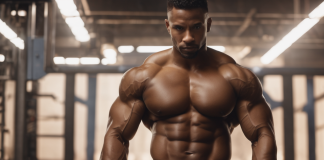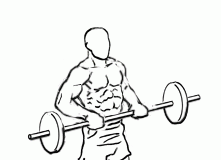Last Updated on September 26, 2014
The Seated Triceps Press with Dumbbell is a classic exercise aimed at building and defining the triceps, the muscles on the back of your upper arms. When developed, strong triceps give your arms a balanced, muscular appearance and support overall arm functionality in many upper body exercises. Not only does this exercise help improve arm strength and aesthetics, but it also enhances stability in the shoulders and core.
In this guide, we’ll dive deep into how to master the Seated Triceps Press, avoid common mistakes, and make the most of this powerful exercise. Whether you’re a beginner or a seasoned lifter, this guide will provide everything you need to elevate your workout.
1. Exercise Overview: What is the Seated Triceps Press with Dumbbell?
The Seated Triceps Press with Dumbbell is a compound exercise that focuses primarily on the triceps, though it also engages the shoulders and core for stabilization. This exercise involves using a single dumbbell, held by both hands, to press the weight overhead and lower it behind your head in a controlled motion.
This movement isolates the triceps effectively, making it ideal for those looking to improve their upper arm strength and definition. By sitting during the exercise, you eliminate the need for lower body stability, allowing you to concentrate fully on working the triceps.
2. Step-by-Step Guide to Performing the Seated Triceps Press
Step 1: Setting Up for Success
- Find a short, straight-backed bench that allows you to keep your feet planted firmly on the floor. Sitting on a bench ensures better posture and reduces the risk of using momentum, which can compromise form and effectiveness.
- Position your feet shoulder-width apart, firmly grounded to help you stay balanced.
Step 2: Grasping the Dumbbell
- Hold the dumbbell with both hands. Use a palms-up grip, cupping the weight from underneath. This grip provides control and keeps the weight from shifting, ensuring a safe and effective workout.
- Choose a weight you can manage without compromising form. For beginners, start with a moderate weight to understand the movement fully before progressing to heavier loads.
Step 3: Starting Position
- Lift the dumbbell overhead with your arms extended, keeping your elbows close to your head. Your elbows should be pointing forward rather than out to the sides.
- Brace your core and draw your shoulders back slightly to maintain good posture and prevent arching your lower back, which could lead to strain.
Step 4: Lowering the Dumbbell
- Slowly lower the dumbbell in an arc motion until it reaches just behind your head. Your forearms should be close to your biceps, and your elbows remain stable, pointing forward.
- Aim to lower until you feel a stretch in your triceps. Moving too fast can place undue stress on your joints, so focus on control throughout the movement.
Step 5: Returning to the Starting Position
- Push the dumbbell back up in a smooth, controlled motion until your arms are extended overhead.
- Avoid locking out your elbows at the top, as this can reduce tension on the triceps and put unnecessary stress on your elbow joints.
3. Benefits of the Seated Triceps Press
The Seated Triceps Press offers several key benefits that make it a valuable addition to your workout routine:
- Tricep Strength and Definition: This exercise isolates the triceps, helping to develop strength and size. As the triceps are involved in various pushing movements, stronger triceps improve performance in exercises like bench presses and pushups.
- Improved Upper Body Stability: Keeping the dumbbell stable overhead works the shoulders and core, enhancing upper body stability. The exercise challenges the smaller stabilizer muscles, leading to better control and balance in other compound exercises.
- Functional Strength for Everyday Tasks: Strengthening the triceps has functional benefits, aiding in everyday activities like lifting, pushing, and reaching overhead. Strong triceps can reduce the risk of injury in daily movements and other exercises.
4. Common Mistakes to Avoid
To get the most out of the Seated Triceps Press, avoid these common errors:
- Arching the Lower Back: Arching the back places stress on the spine and can lead to injury. To prevent this, engage your core and keep your elbows close to your head. This helps you maintain proper alignment and focus tension on the triceps.
- Using Momentum: Some people tend to “swing” the weight, using momentum instead of muscle control. This minimizes triceps engagement and increases the risk of strain. Ensure each movement is slow and deliberate.
- Allowing Elbows to Flare Out: When elbows flare out, it shifts focus away from the triceps and onto the shoulders, reducing the effectiveness of the exercise. To correct this, keep your elbows pointing forward and close to your head.
- Inappropriate Weight Choice: Choosing a weight that’s too heavy can lead to form breakdown, which increases injury risk. Start with a lighter weight and focus on controlled form before advancing to heavier weights.
5. Tips to Maximize Results
Here are some tips to help you get the most from the Seated Triceps Press:
- Warm-Up First: Spend a few minutes warming up your shoulders, arms, and core before starting. Simple stretches or light cardio helps prepare your muscles and joints for the exercise.
- Use Progressive Overload: Progressively increase the weight, reps, or sets to build strength over time. Aim for small increments to avoid overloading the muscles.
- Practice Controlled Breathing: Inhale as you lower the dumbbell behind your head and exhale as you press it back up. This breathing rhythm helps stabilize your core, reducing unnecessary strain on your neck and shoulders.
- Use a Spotter if Needed: If you’re attempting heavier weights, especially as a beginner, having a spotter can provide an extra layer of safety.
6. Variations and Modifications
To keep your routine fresh or adjust the intensity, try these variations:
- Single-Arm Seated Triceps Press: Using one arm at a time can help address muscle imbalances and give each tricep equal focus. Use a lighter weight and focus on controlling the dumbbell through each movement.
- Standing Triceps Press with Dumbbell: This version requires more balance and core engagement, as you won’t have the bench for stability. Standing up adds a functional challenge but may not be suitable for beginners.
- Seated Overhead Triceps Extension with Barbell: Using a barbell can increase stability, allowing for heavier weights. It’s easier to control the barbell, but you’ll need to pay extra attention to keep your elbows close together.
- Alternating Dumbbell Seated Press: Alternate between pressing with one dumbbell in each hand to enhance focus on each arm. This variation helps balance both sides of the body, promoting equal strength development.
7. Integrating the Seated Triceps Press with Dumbbell into Your Workout Routine
Adding the Seated Triceps Press into your workout routine can improve upper arm strength and aesthetics. Here’s how to incorporate it effectively:
- Reps and Sets Recommendations: For muscle growth, aim for 3 sets of 8-12 reps. If you’re working on endurance, go for higher reps (12-15) with slightly lighter weights.
- Best Pairings: Pair the Seated Triceps Press with chest or shoulder exercises for a well-rounded upper body workout. Some examples include bench presses, shoulder presses, and pushups.
- Rest Intervals: Allow 60-90 seconds of rest between sets to give your muscles time to recover while keeping the workout intensity high.
8. How to Track Progress
Tracking your progress ensures consistent improvement and helps you stay motivated. Here’s how:
- Log Your Weight and Reps: Keep a journal or use a fitness app to track the weight and reps for each session. Monitoring progress over time will show tangible improvements.
- Check Your Form: Record yourself performing the exercise occasionally or ask a trainer to ensure your form stays consistent, especially as you increase the weight. Maintaining good form is essential to avoid injury and ensure progress.
- Monitor Strength Gains: Set short-term goals, such as increasing the weight by a small amount every few weeks. As your triceps get stronger, you’ll notice improvements in other upper body exercises like pushups, bench presses, and overhead presses.
9. Frequently Asked Questions
Q: Can I perform this exercise if I have shoulder issues? A: If you have shoulder pain or injury, consult a medical professional before attempting this exercise. Modifications, like reducing the range of motion or using a lighter weight, may be helpful, but always get professional advice.
Q: How often should I do the Seated Triceps Press? A: This exercise can be included 1-2 times per week in your upper body or arm-focused workouts. Allow at least 48 hours of rest before repeating the same exercise to avoid overtraining.
Q: What if I don’t have a bench? A: You can perform a standing version of the Triceps Press, though it will engage your core more and may not allow for as much weight. Ensure you maintain control and good posture throughout the movement.
Conclusion
The Seated Triceps Press with Dumbbell is a powerful exercise for anyone looking to build stronger, well-defined triceps. It’s effective, versatile, and can easily be tailored to fit any fitness level. Remember, form is key to maximizing benefits and avoiding injury. By following the steps, tips, and variations outlined in this guide, you can integrate the Seated Triceps Press into your routine and enjoy the long-term benefits of improved upper body strength and stability.
So, next time you’re at the gym, grab a dumbbell, focus on your form, and get ready to build stronger, more defined triceps!








